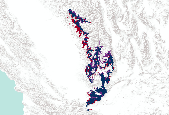Filters: Tags: scenario (X)
317 results (11ms)|
Filters
Date Range
Extensions Types
Contacts
Categories Tag Types
|
The Vista tool is used to create a Scenario of the native biotic integrity CAs affecting the North American Warm Desert Playa and Ephemeral Lake CE and applies user-input Landscape Condition Model (LCM) scores to generate ESAs for each of the CEs. The LCM consists of Site Impact scores and impact Distances for each CA category. Site Impact scores are a value between 0 and 1 representing the impact of the CA on the relevant CEs. A score close to 1 indicates negligible or no impact from that CA. A score close to 0 indicates the highest possible impact, e.g. an interstate highway that makes the area in which it occurs completely unsuitable for the CE. Distances are set in meters and extend the impact of the CA from...
The Vista tool is used to create a Scenario of the native biotic integrity CAs affecting the North American Warm Desert Ciénega and Marsh CE and applies user-input Landscape Condition Model (LCM) scores to generate ESAs for each of the CEs. The LCM consists of Site Impact scores and impact Distances for each CA category. Site Impact scores are a value between 0 and 1 representing the impact of the CA on the relevant CEs. A score close to 1 indicates negligible or no impact from that CA. A score close to 0 indicates the highest possible impact, e.g. an interstate highway that makes the area in which it occurs completely unsuitable for the CE. Distances are set in meters and extend the impact of the CA from the footprint...
The Vista tool is used to create a Scenario of the development CAs affecting the Apacherian Chihuahuan Semi-Desert Grassland and Steppe CE and applies user-input Landscape Condition Model (LCM) scores to generate ESAs for each of the CEs. The LCM consists of Site Impact scores and impact Distances for each CA category. Site Impact scores are a value between 0 and 1 representing the impact of the CA on the relevant CEs. A score close to 1 indicates negligible or no impact from that CA. A score close to 0 indicates the highest possible impact, e.g. an interstate highway that makes the area in which it occurs completely unsuitable for the CE. Distances are set in meters and extend the impact of the CA from the footprint...
The Vista tool is used to create a Scenario of the invasives CAs affecting the Apacherian Chihuahuan Semi-Desert Grassland and Steppe CE and applies user-input Landscape Condition Model (LCM) scores to generate ESAs for each of the CEs. The LCM consists of Site Impact scores and impact Distances for each CA category. Site Impact scores are a value between 0 and 1 representing the impact of the CA on the relevant CEs. A score close to 1 indicates negligible or no impact from that CA. A score close to 0 indicates the highest possible impact, e.g. an interstate highway that makes the area in which it occurs completely unsuitable for the CE. Distances are set in meters and extend the impact of the CA from the footprint...
The Vista tool is used to create a Scenario of the CAs affecting the Madrean Montane Conifer-Oak Forest and Woodland CE and applies user-input Landscape Condition Model (LCM) scores to generate ESAs for each of the CEs. The LCM consists of Site Impact scores and impact Distances for each CA category. Site Impact scores are a value between 0 and 1 representing the impact of the CA on the relevant CEs. A score close to 1 indicates negligible or no impact from that CA. A score close to 0 indicates the highest possible impact, e.g. an interstate highway that makes the area in which it occurs completely unsuitable for the CE. Distances are set in meters and extend the impact of the CA from the footprint out for the specified...

This dataset depicts Lynx (Lynx canadensis) habitat in the Northern Appalachians predicted using the spatially explicit population model PATCH under the no population cycling scenario (A1; Carrol 2007). This dataset represents one of several scenarios testing the interacting effects of population cycling, trapping, territory size, and climate change on lynx populations. Static habitat suitability models for lynx were fed through PATCH to predict source and sink habitat areas across the landscape. The static models for lynx were created based on a logistic regression model of reported lynx locations against the proportion of the landscape in deciduous forest cover and annual snowfall. Demographic parameters were...

This dataset represents presence of Red Pine (Pinus resinosa) at year 150 (2145) in Minnesota (USA) from a single model run of LANDIS-II. The simulation assumed Intergovernmental Panel on Climate Change (IPCC) B2 emissions (moderate) and used the Hadley 3 global circulation model. Contemporary harvest rates and intensities were simulated.

This dataset represents presence of Jack Pine (Pinus banksiana) in Minnesota (USA) at year 50 (2045) from a single model run of LANDIS-II. The simulation assumed Intergovernmental Panel on Climate Change (IPCC) B2 emissions (moderate) and used the Hadley 3 global circulation model. Contemporary harvest rates and intensities were simulated.

This dataset represents presence of Jack Pine (Pinus banksiana) in Minnesota (USA) at year 0 (1995) from a single model run of LANDIS-II. The simulation assumed Intergovernmental Panel on Climate Change (IPCC) B2 emissions (moderate) and used the Hadley 3 global circulation model. Contemporary harvest rates and intensities were simulated.

This dataset represents presence of Sugar Maple (Acer saccharum) at year 0 (1995) from a single model run of LANDIS-II. The simulation assumed Intergovernmental Panel on Climate Change (IPCC) B2 emissions (moderate) and used the Hadley 3 global circulation model. Restoration harvest rates and intensities were simulated.

This dataset represents presence of Black Spruce (Picea mariana) at year 50 (2045) from a single model run of LANDIS-II. The simulation assumed Intergovernmental Panel on Climate Change (IPCC) B2 emissions (moderate) and used the Hadley 3 global circulation model. Contemporary harvest rates and intensities were simulated.

The Nature Conservancy (TNC) has derived climate suitability forecasts for most species of trees and shrubs considered to be ecological dominants of terrestrial Californian habitat types. Our plant projections are compiled as decision support tools to help Conservancy project staff, as well as our external partners, develop the necessary plans, priorities and strategies to successfully adapt to uncertain changes in future climate. In the recently completed Southern Sierra Partnership's 2010 Climate-Adapted Conservation Plan for the Southern Sierra Nevada and Tehachapi Mountains, species and habitat forecasts shown here informed the development of a regional conservation design that explicitly incorporates long-term...

The Nature Conservancy (TNC) has derived climate suitability forecasts for most species of trees and shrubs considered to be ecological dominants of terrestrial Californian habitat types. Our plant projections are compiled as decision support tools to help Conservancy project staff, as well as our external partners, develop the necessary plans, priorities and strategies to successfully adapt to uncertain changes in future climate. In the recently completed Southern Sierra Partnership's 2010 Climate-Adapted Conservation Plan for the Southern Sierra Nevada and Tehachapi Mountains, species and habitat forecasts shown here informed the development of a regional conservation design that explicitly incorporates long-term...

The Nature Conservancy (TNC) has derived climate suitability forecasts for most species of trees and shrubs considered to be ecological dominants of terrestrial Californian habitat types. Our plant projections are compiled as decision support tools to help Conservancy project staff, as well as our external partners, develop the necessary plans, priorities and strategies to successfully adapt to uncertain changes in future climate. In the recently completed Southern Sierra Partnership's 2010 Climate-Adapted Conservation Plan for the Southern Sierra Nevada and Tehachapi Mountains, species and habitat forecasts shown here informed the development of a regional conservation design that explicitly incorporates long-term...

The Nature Conservancy (TNC) has derived climate suitability forecasts for most species of trees and shrubs considered to be ecological dominants of terrestrial Californian habitat types. Our plant projections are compiled as decision support tools to help Conservancy project staff, as well as our external partners, develop the necessary plans, priorities and strategies to successfully adapt to uncertain changes in future climate. In the recently completed Southern Sierra Partnership's 2010 Climate-Adapted Conservation Plan for the Southern Sierra Nevada and Tehachapi Mountains, species and habitat forecasts shown here informed the development of a regional conservation design that explicitly incorporates long-term...

The Nature Conservancy (TNC) has derived climate suitability forecasts for most species of trees and shrubs considered to be ecological dominants of terrestrial Californian habitat types. Our plant projections are compiled as decision support tools to help Conservancy project staff, as well as our external partners, develop the necessary plans, priorities and strategies to successfully adapt to uncertain changes in future climate. In the recently completed Southern Sierra Partnership's 2010 Climate-Adapted Conservation Plan for the Southern Sierra Nevada and Tehachapi Mountains, species and habitat forecasts shown here informed the development of a regional conservation design that explicitly incorporates long-term...

The Nature Conservancy (TNC) has derived climate suitability forecasts for most species of trees and shrubs considered to be ecological dominants of terrestrial Californian habitat types. Our plant projections are compiled as decision support tools to help Conservancy project staff, as well as our external partners, develop the necessary plans, priorities and strategies to successfully adapt to uncertain changes in future climate. In the recently completed Southern Sierra Partnership's 2010 Climate-Adapted Conservation Plan for the Southern Sierra Nevada and Tehachapi Mountains, species and habitat forecasts shown here informed the development of a regional conservation design that explicitly incorporates long-term...

The Nature Conservancy (TNC) has derived climate suitability forecasts for most species of trees and shrubs considered to be ecological dominants of terrestrial Californian habitat types. Our plant projections are compiled as decision support tools to help Conservancy project staff, as well as our external partners, develop the necessary plans, priorities and strategies to successfully adapt to uncertain changes in future climate. In the recently completed Southern Sierra Partnership's 2010 Climate-Adapted Conservation Plan for the Southern Sierra Nevada and Tehachapi Mountains, species and habitat forecasts shown here informed the development of a regional conservation design that explicitly incorporates long-term...

The Nature Conservancy (TNC) has derived climate suitability forecasts for most species of trees and shrubs considered to be ecological dominants of terrestrial Californian habitat types. Our plant projections are compiled as decision support tools to help Conservancy project staff, as well as our external partners, develop the necessary plans, priorities and strategies to successfully adapt to uncertain changes in future climate. In the recently completed Southern Sierra Partnership's 2010 Climate-Adapted Conservation Plan for the Southern Sierra Nevada and Tehachapi Mountains, species and habitat forecasts shown here informed the development of a regional conservation design that explicitly incorporates long-term...

The Nature Conservancy (TNC) has derived climate suitability forecasts for most species of trees and shrubs considered to be ecological dominants of terrestrial Californian habitat types. Our plant projections are compiled as decision support tools to help Conservancy project staff, as well as our external partners, develop the necessary plans, priorities and strategies to successfully adapt to uncertain changes in future climate. In the recently completed Southern Sierra Partnership's 2010 Climate-Adapted Conservation Plan for the Southern Sierra Nevada and Tehachapi Mountains, species and habitat forecasts shown here informed the development of a regional conservation design that explicitly incorporates long-term...
|

|